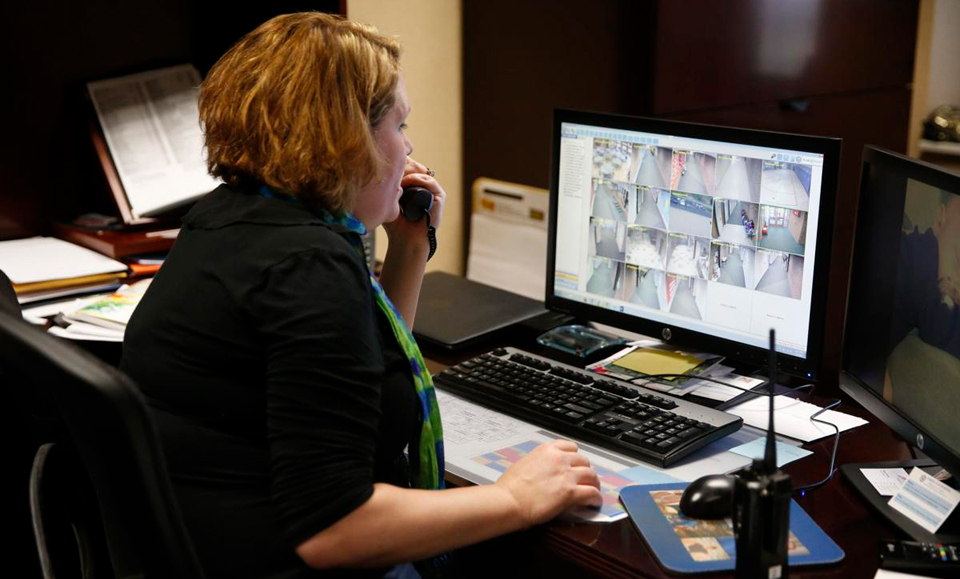
WASHINGTON—Imagine a shaking, scared kindergartener or pre-schooler hiding in a closet or under her desk, hoping and praying the man with the gun won’t shoot her – and being scared of loud noises and similar phenomena for the rest of her life?
Real, right? Real all too often since the Columbine High School massacre in Colorado 20 years ago? Even more real since the Marjory Stoneman Douglas High School murders of 14 students and three teachers on Valentine’s Day, 2018, right?
Correct. Except in the cases we’re talking about, the kids are hiding during an “active shooter” lockdown drill and the gun-wielder is acting a role – although in one such elementary school drill in Monticello, Ind., law enforcement officers lined teachers up and “shot” them with air gun pellets. The teachers, too, were traumatized.
And the students, some as young as three or four years old, suffer mental and emotional harm from such drills, a new report sponsored by the nation’s two big teachers unions and commissioned by a top gun-control group, Everytown for Gun Safety, says.
This is why the National Education Association, the American Federation of Teachers (AFT) and Everytown recommend such drills, now present in 95% of U.S. schools, be drastically overhauled, if not outright abolished, because as they’re structured now, they do more harm than good. “Chaotic” and “traumatic” were among the descriptions in the report.
And if you’re going to keep school kids practicing lockdown drills, the report adds, tell them in advance it’s only a drill, and there shouldn’t be a role-playing gun wielder in the room. The drill should also be age-specific and geared to what the students can mentally and emotionally handle, the report adds.
That’s especially true in schools where students have suffered the trauma of seeing loved ones – or their fellow students – murdered, the report, issued on Feb. 11, says. That means not just students in schools, but also students who come to school from dangerous neighborhoods riven with gun violence.
The issue of what to do about preparing for active shooters in schools gained momentum almost exactly two years before the report was issued, due to the Valentine’s Day 2018 massacre in Florida.
Those killings touched off further debate. GOP Trump administration Education Secretary Elizabeth “Betsy” DeVos, who hates public schools, their kids and their unionized teachers, demanded schools arm all teachers and staff. So did the notorious gun lobby, the radical right-wing National Rifle Association.
Some school districts in rural red areas and states adopted DeVos’s idea. But the overwhelming majority of teachers and staffers, plus the two unions, insistently rejected it.
The Parkland survivors formed and led the nationwide “March for our Lives” pro-gun-control movement. Millions of students engaged in mass marches and lobbying for sensible gun control legislation, succeeding in many states, though not in Congress, due to Republican fealty to the notorious gun lobby, the National Rifle Association.
And both NEA and AFT took the lead in lobbying and marching with the students. Anticipating Congress would block the laws, March for our Lives added another demand: “If they don’t get it, vote them out.” Student voting in the 2018 election more than doubled and at least half-a-dozen GOP congressional gun nuts lost their seats.
That still leaves the question of what to do about the active shooter drills. AFT President Randi Weingarten doesn’t believe they work. “Those terrifying and traumatizing drills — they have no basis in fact and they harm more than they have ever helped,” she told National Public Radio. NEA had no additional comment, beyond tacit endorsement of the report.
“Given growing concern among parents, students, educators, and medical professionals about the impact active shooter drills can have on student development, Everytown, AFT, and NEA do not recommend these drills for students and believe schools should carefully consider these impacts before conducting live drills that involve students and educators,” it says.
But if the schools conduct the drills, they should follow six important principles to help protect the kids. They include no “simulations that mimic an actual incident,” advance notice to parents, advance announcements to teachers and students, and “age and developmentally appropriate drill content with the involvement of school personnel, including school-based mental health professionals.”
And “schools should couple drills with trauma-informed approaches to address students’ well-being.” They also should develop data – there is very little if any right now – “about the efficacy and effects of drills.”
“Drills involving students should not be the only plan to respond to school shootings. If schools decide to adopt these drills, they must be part of a comprehensive safety plan that includes measures to prevent active shooter incidents from happening in the first place, such as threat assessment programs, access to mental health professionals, collaborating with law enforcement, and engaging the community to ensure guns are not easily accessible,” the report adds.










